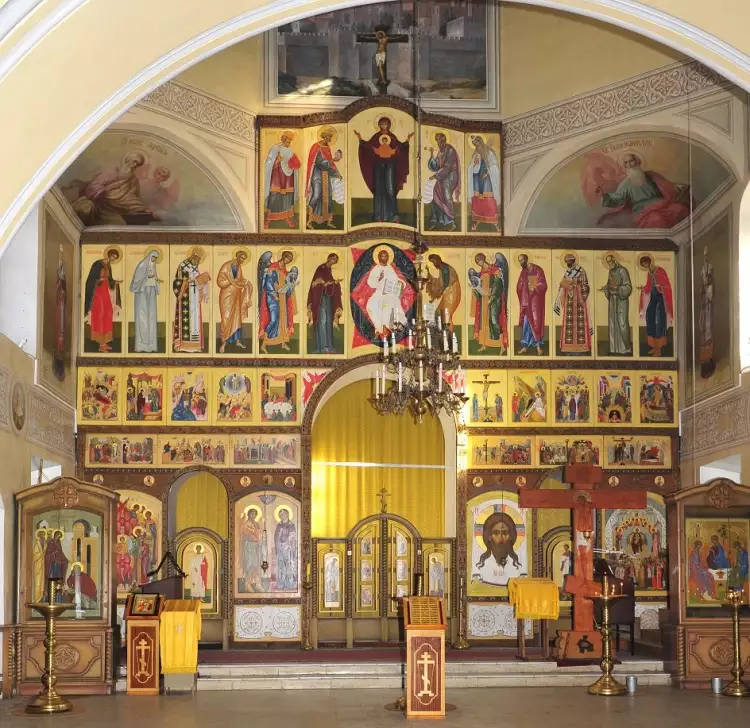
The most famous Orthodox icons
Iconography is a form of artistic expression. However, unlike other forms, it carries much deeper meanings and significance. The mission of a sacred work is fundamentally different from that of paintings, even those of a spiritual nature. Few Orthodox iconographers are well-known; moreover, holy images were often created collectively, with the master artist drawing the face while assistants contributed to the rest. Here is a list of perhaps the five most famous icons in the Orthodox world.
 The most famous Orthodox icons. Iconostasis in the church
The most famous Orthodox icons. Iconostasis in the church
The Icon of the Vladimir Mother of God (Virgin of Vladimir)
One of the most revered images in Russian Orthodoxy is the Vladimir icon depicting the Mother of God. According to legend, it is attributed to the hand of the evangelist Luke. The image, as the legend goes, was applied to a wooden table around which the Savior, the Virgin Mary, and the righteous Joseph gathered for a meal.
 The most famous Orthodox icons. The Icon of the Vladimir Mother of God, 1131
The most famous Orthodox icons. The Icon of the Vladimir Mother of God, 1131
The icon arrived in Russia in the year 1131 as a gift to Yuri Dolgorukiy (Russian: Юрий Долгорукий). Since then, it has protected Russia from foreign invaders and worked miracles. For instance, it is said that the icon saved Russian land from Tamerlane, in 1480 from the devastation by the Golden Horde led by Akhmat, and in 1521, it saved Moscow from the defeat by the Kazan khan Mehmed-Girey.
"The Trinity" by Andrei Rublev
One of the most famous icons in the Orthodox world is located in the Tretyakov Gallery - The Trinity, painted by Andrei Rublev (Russian: Андрей Рублёв) - the master's most famous work. It was created in the early 15th century (the exact date is difficult for specialists to determine) for the majestic stone Trinity Cathedral.
 The most famous Orthodox icons. Andrei Rublev. The Trinity, 1425
The most famous Orthodox icons. Andrei Rublev. The Trinity, 1425
It was intended for the icon to be placed to the right of the Royal Gates. The image is multifaceted and layered, filled with symbols and meanings. Therefore, there have been numerous scholarly studies dedicated to the subject of this masterpiece.
The Icon of Our Lady of Kazan
The miraculous canonical icon was discovered in the middle of the summer of 1579, a quarter of a century after the conquest of the Kazan Khanate by Ivan the Terrible. Patriarch Hermogenes wrote that on the eve of July 8, the day of the relic's discovery, a strong fire occurred in Kazan, resulting in the burning of half the city, including part of the Kremlin. The Tatars rejoiced, claiming that divine forces had punished the evildoers who encroached on Muslim lands. Archer Daniil Onuchin planned to build a new house on the site of the burned one, but he was stopped by Matrona's ten-year-old daughter.
 The most famous Orthodox icons. The Icon of Our Lady of Kazan, 1579
The most famous Orthodox icons. The Icon of Our Lady of Kazan, 1579
The girl told that the Mother of God had appeared to her in a dream and instructed her to find the image at the site of the future construction. The little girl was dismissed, but she insisted again and again that the ashes needed to be excavated.
In the end, the girl prevailed, and they began to clear away the ashes and remnants of the burned building. It was there that the icon of Our Lady of Kazan was found. The miraculous icon healed diseases and inspired warriors; Peter I and Mikhail Kutuzov prayed before it on the eve of great campaigns. In the early 20th century, the icon was destroyed, but numerous copies spread throughout the world. The earliest can be seen in the Tretyakov Gallery.
"Spas Nerukotvornyi" by Simon Ushakov
Perhaps the most interesting ancient icon, "Spas Nerukotvornyi," was painted in 1658 in the workshop of Simon Ushakov (Russian: Симон Ушаков), a 17th-century royal icon painter. It is interesting for its non-canonical nature and realism - prior to this, images were painted according to strict rules. The face of the Savior on the cloth looks human and benevolent, even the eyelashes are carefully depicted - which is uncharacteristic for ancient Russian iconography.
 The most famous Orthodox icons. Simon Ushakov. Spas Nerukotvornyi, second half of the 12th century
The most famous Orthodox icons. Simon Ushakov. Spas Nerukotvornyi, second half of the 12th century
The icon is based on a biblical legend. Once, the Savior washed His face, wiped it with a towel, and His image remained on the fabric. It became the first image of Jesus. "Spas Nerukotvornyi" image is one of the most sacred and revered in Christianity. And it was repeatedly reproduced by Simon Ushakov in his creations. The most famous cloth created by Ushakov is now carefully preserved in the Tretyakov Gallery.
"Spas v silah" by Andrei Rublev
The icon "Spas v silah" by the famous Andrei Rublev is very symbolic. According to the creator's intention, it represents the image of Christ at the center of the Universe. In fact, it is a visual scheme of the Christian cosmogony with all its attributes.
 The most famous Orthodox icons. Andrei Rublev. Spas v silah, 1408
The most famous Orthodox icons. Andrei Rublev. Spas v silah, 1408
The icon "The Savior of Power" is one of the most important relics in Orthodoxy, and therefore it is always placed in the center of the iconostasis, above the Royal Gates. The image by Andrei Rublev is now in the Tretyakov Gallery, in a glass sarcophagus, where special conditions have been created for its preservation.
 Pablo Picasso was a recognized genius of 20th-century art
Pablo Picasso was a recognized genius of 20th-century art  The painting "Portrait of an Artist (Pool with Two Figures)" by David Hockney is a cult work by the most influential contemporary artist
The painting "Portrait of an Artist (Pool with Two Figures)" by David Hockney is a cult work by the most influential contemporary artist  Animalism is a popular genre in painting from prehistoric times
Animalism is a popular genre in painting from prehistoric times  The art of Ancient Rome is a great creative legacy for many generations of descendants
The art of Ancient Rome is a great creative legacy for many generations of descendants  Anatoly Zverev — an unrecognized genius of the Soviet era
Anatoly Zverev — an unrecognized genius of the Soviet era  Marine landscape is the most romantic genre of visual art: history, artists, and paintings
Marine landscape is the most romantic genre of visual art: history, artists, and paintings  The engraving "Rhinoceros" by Albrecht Dürer - Europe's acquaintance with a curious beast
The engraving "Rhinoceros" by Albrecht Dürer - Europe's acquaintance with a curious beast  Hermann Historica's Anniversary Auction is a triumph
Hermann Historica's Anniversary Auction is a triumph  Auction: essence, types, history, the most famous art auctions
Auction: essence, types, history, the most famous art auctions  The Return of Nature: Embracing Nature Renewal Art in 2024
The Return of Nature: Embracing Nature Renewal Art in 2024